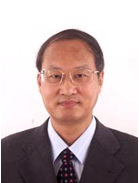
庞代文
武汉大学化学与分子科学学院教授、生物医学分析化学教育部重点实验室主任、国家纳米科学技术指导协调委员会委员、“纳米研究”国家重大科学研究计划专家组成员、国家自然科学基金委化学部专家评审组成员。New Journal of Chemistry、Journal of Electroanalytical Chemistry、Cell & Bioscience等13种国际、国内学术期刊编委等。曾任武大化学与分子科学学院院长(2001.01-2005.02)。专长纳米(量子点)生物技术和生物医学分析化学。发表SCI论文220余篇,编著2本,获授权国家发明专利23项,鉴定成果4项,参与制订第1个量子点国家标准。论文的SCI他人引用4900多次,H指数40,125次在国内外作大会特邀报告和特邀专题报告(其中国际特邀报告55次)。“活细胞合成量子点等纳米材料”研究成果被遴选为《“十一五”国家重大科技成就展(2011年3月7日-13日,北京)》参展成果。曾获教育部自然科学一等奖(第1完成人,2006年)、宝钢教育奖优秀教师奖、全国教育系统先进工作者、全国优秀科技工作者,享受国务院政府特殊津贴。2005年3月以其实验室为技术依托创办了“武汉珈源量子点技术开发有限公司”。“量子点新型荧光标记试剂”获“第七届中国国际高新技术成果交易会”“优秀产品奖”。目前,致力于发展基于量子点标记的纳米生物检测与动态成像新方法,包括单病毒颗粒实时动态跟踪以及肿瘤转移研究的活体原位实时动态示踪与成像新方法,细菌及病毒的快速高灵敏检测新方法等。
Dr. Dai-Wen Pang is professor of chemistry at Wuhan University (China), director of the Key Laboratory of Analytical Chemistry for Biology and Medicine (MOE, China). He is also the Technical Founder of Wuhan Jiayuan Quantum Dots Co., Ltd.He was the Dean ofthe CollegeofChemistryand Molecular Sciences,Wuhan University,Chinafrom 2001 to 2005.His main interests focus on thedevelopment ofquantum dots (QDs), including live-cell synthesis of QDs, quasi-bio synthesis of QDs, QDs-based real-time tracking of single viruses infecting their host cells, and QDs-based bioimagingfor tumor metastasis and cancer diagnosis. He and his coworkers have put forward a new strategy of ‘Space-Time Coupling’,namely, in time and space, coupling intracellular irrelated biochemical reactionsto controllably synthesize QDs in live cells, by whichcolor-tunable fluorescent CdSe nanocrystals can becontrollably prepared in live yeast cells, without using any combustible, explosible and toxic organic reagents, and cells can be efficiently transformed intohighly stable and ultrasensitive bioprobes filled with in-cell synthesized fluorescent CdS0.5Se0.5QDs, with a perfectly uniform size and uniform fluorescence intensity.His group hassolved the problems for safe, high-efficiency and low-cost preparation of fluorescent core/shell CdSe/ZnS semiconductor QDs in a large scale. Also, they have established multiple methods,e.g.quasi-biosystems for synthesis of near infrared QDs such as Ag2Se, Ag2S, PbSe and so on. His group has proposed a new strategy for electrochemical tuning of luminescent carbon nanodots, by which the size,surface oxidation state and corresponding luminescence properties of carbon nanodots can be tuned. They have found that surface states are the key to the luminescence of carbon nanodots.Accordingly, they constructed a variety of QD-based nanobioprobes, such as multicolor fluorescent-magnetic-biotargeting multifunctional nanobioprobesetc., for diverse biomedical applications. He is the author for over 220 research publications in peer-reviewed international journals, 23 authorized patents and one national standard for quantum dots. He has delivered 125 invited lectures. He has been awarded the National Science Fund for Distinguished Young Scholars in 2000 by the NSFC, the First Award of the Natural Science Prize of the Ministry of Education of China (Dec. 2006), and the National Excellent Scientist (Dec. 2012)etc.. Their work on “Synthesis of nanomaterials such as quantum dots in live cells” was officially selected and showcased at the Exhibition (7-13 Mar 2011, Beijing) on Major National Science & Technology Achievements of the “11th Five-year Plan” (2006-2010)of China.



 武大主页
武大主页 武大邮箱
武大邮箱 信息门户
信息门户 English
English